#lazare carnot
Explore tagged Tumblr posts
Text
If you Hug different revolutionaries
Maximilien robespierre-You will feel how tiny and skinny he is. His body temperature is a bit low. He never hugs anyone tightly.
Antoine Saint-Just-His body is a bit hard since he has a strong built. But it is warm especially close to his heart.
Camille Desmoulins-He will pat you happily and lightly when hugging you, with a smile on his face. Then you'll be able to hear him humming a song.
Georges Danton-He likes to hug anyone tightly with his large arms. You can smell the odor of wine from him.
Jean-Paul Marat-He hugs you firmly. You might feel the strength of his hands. He hugs you because he trusts you deeply.
Augustin Robespierre-Recommend to hug him when it is extremely cold outside.
Lazare Carnot-You feel something wet on your head. He is crying!
Claude Antoine Prieur-A very sincere hug you will receive. He will hug you with a ruler and a compass in his hand.
Billaud Varenne-You might feel like crashing into a stone. He only hugs Collot warmly.
Collot d'Herbois-Throwing his body on you, just guess how he feels about you.
BTW, feel free to correct the mistakes from my headcanons.
#french revolution#frev#maximilien robespierre#robespierre#saint just#lazare carnot#jean paul marat#danton#camille desmoulins#billaud varenne#collot d'herbois#augustin robespierre#claude antoine prieur
92 notes
·
View notes
Text

173 notes
·
View notes
Text
Frev-related snapshots from Paris compilation ✨
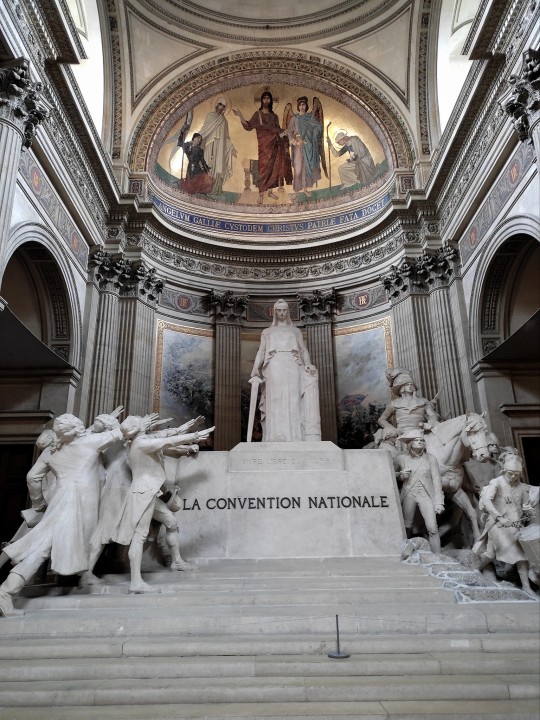
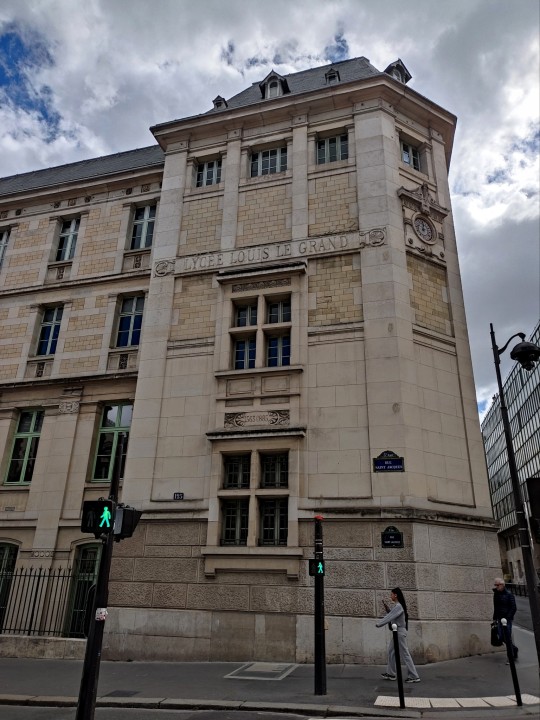

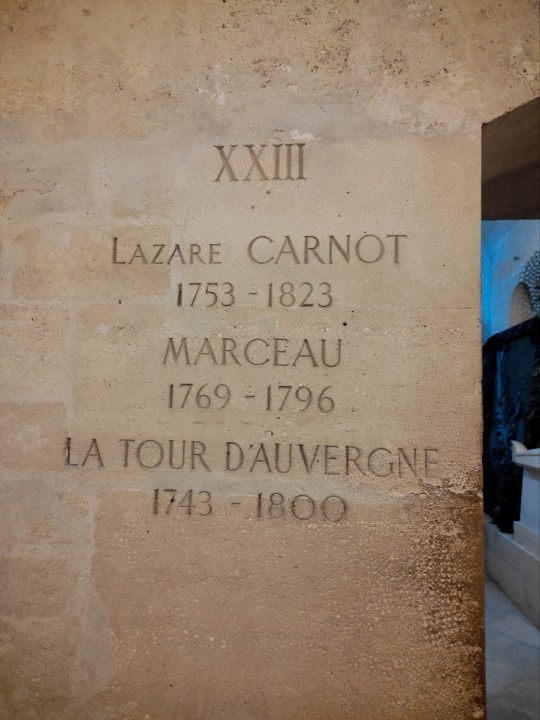

1. La Convention Nationale monument inside Pantheon
2. Louis le Grand (hopefully?) spotted in the wild, but it should be Robespierre and Desmoulins' school, right?
3. Liberté, Egalité, Fraternité (felt surreal seeing my old header design irl!)
4. Carnot's tomb inside Pantheon
5. Monument to French Revolution's generals
#frev#french revolution#frev community#frev art#paris#paris trip#lazare carnot#maximilien robespierre#camille desmoulins#history#french history#1700s#more to come!#photography
154 notes
·
View notes
Text
dinosaur named ‘Carnotaurus’ discovered by a man named ‘Bonaparte’

69 notes
·
View notes
Text
Concept: one single 'this is our get along shirt' shirt for everyone in the CSP
#frev#the csp#maximilien robespierre#louis antoine de saint just#lazare carnot#collot d'herbois#barère#georges couthon#billaud varenne#lindet#prieur x 2#saint-andré (i always forget him)#hérault de séchelles#frev shitposting
45 notes
·
View notes
Note
more theatre kid collot pls ill give u everything
yes. 🙂

also @citizen-card your tags on the first Collot theatre kid post really deserved to be drawn too


#french revolution#frev#collot d'herbois#lazare carnot#claude antoine prieur#robert lindet#camille desmoulins#augustin robespierre#bonbon robespierre#napoleon bonaparte#i'm such a sucker for the playing a tree trope i had to do this
74 notes
·
View notes
Text
Today I finally decided to check something a friend told me a while ago. It was about Robespierre allegedly supporting and pushing for a full scale invasion of Italy, an idea that came from his younger brother Augustin and Napoléon.
The evidence for such claim is mentioned in Mary Young's biography on Augustin Robespierre. This is what Young has to say about it:

(page 142).
So not only was Carnot - someone who's considered responsible for turning a war of defense into one of conquest by robespierrist historians - unexpectedly against the idea of invading Piedmont, but Maximilien Robespierre, even more unexpectedly, was pushing for it.
And there's more: at page 154 - 155, Young mentions, quoting a work by J. Colin, that the reason why the CSP fell apart was because Robespierre interfered with war affairs to the point of alienating Carnot. While the latter was indeed against invading foreign countries, Robespierre, on the contrary, approved it and wanted it to be accomplished:

So it seems like the story about great advocate of peace, Maximilien Robespierre, is indeed just a story...!
Because of course a historian, whose book presents a foreword by Marisa Linton, wouldn't completely intentionally or unintentionally twist and misunderstand sources, right?
Right!?
Wrong.
The sources which Young uses to support her ideas are from Histoire de la campagne de 1794 en Italie by Gabriel Fabry vol 2, p. 438 and L’Éducation Militaire de Napoléon by J. Colin. Let's give them a quick look.
Fabry's histoire simply reports a CSP decree showing a certain eagerness in wanting to invade Piedmont. The excerpt, as you can see, doesn't include any signature.

(pages 438 - 439.)
Since Young said that Robespierre approved it, one would be inclined to think that it was Maximilien who wrote and signed the decree, with his signature being the first one. Of course the handwriting and signature of a CSP member isn't absolute proof of approval, but I usually see these two things used as arguments to show that a CSP member agreed; even by reputed historians; so I wasn't surprised to see Young making such a bold assumption. I then checked Aulard's Recueil and surprise surprise that decree was written and signed by Carnot only. No trace of Robespierre:

(I underlined in cyan the part similar to what Fabry reported, since Aulard made only a summary of the decree.)
Concerning the fact that Carnot was opposed to Robespierre's - yes, because Colin considers it as such - warmongering plans, the latter mentions a letter dated 26 Thermidor, in which Carnot complains about it:

I happened to find that letter in Correspondance générale de Carnot vol. 4, p. 575 - 576:
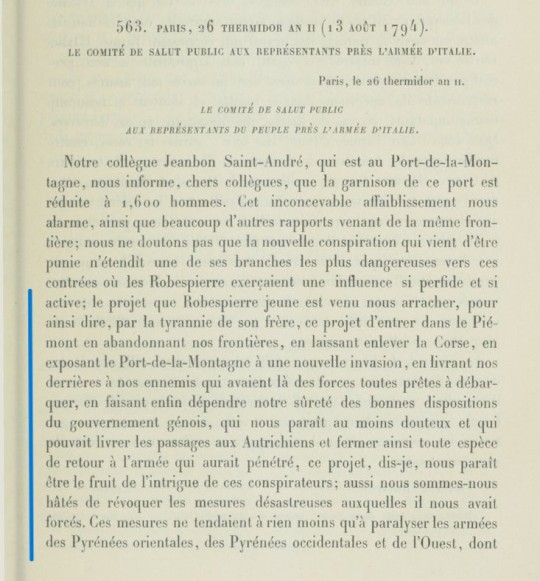
To sum up, it says that the plan comes from the mind of Augustin, but that it was the tyranny of his brother that inspired it.
Now, this is a letter written shortly after the fall of the Robespierrists, it doesn't take much to understand that this is purely thermidorian propaganda, not only because of its content, but also for the wording used. Moreover, it's not a personal letter, in which Carnot rambles with a friend or relative, it's an official one from the Committee of Public Safety.
Saying that Carnot didn't approve the conquest of Piedmont whereas Maximilien Robespierre did - I actually don't know if it was Augustin's idea, but this is not the point right now - is simply wrong since the decree of 19 floréal quoted above has been written and signed exclusively by him.
Thinking that a historian didn't care to double check their sources leading to such a misinformed mess is... truly appalling. This is proof of how one should always double check sources when possible, even if they come from historians we trust or appreciate!
Not that I personally trust or appreciate Young, considering that another of her bizarre claims based on dubious sources almost caused a sort of Thermidor in the community almost one year ago...
EDIT: Mary Young wasn't a historian, but a psychologist, so I did wrong in calling her as such. I do still think that someone of the reputation of Marisa Linton should have done a much better job in reviewing the book.
#frev#french revolution#mary young#augusting robespierre#maximilien robespierre#robespierre#lazare carnot
91 notes
·
View notes
Text
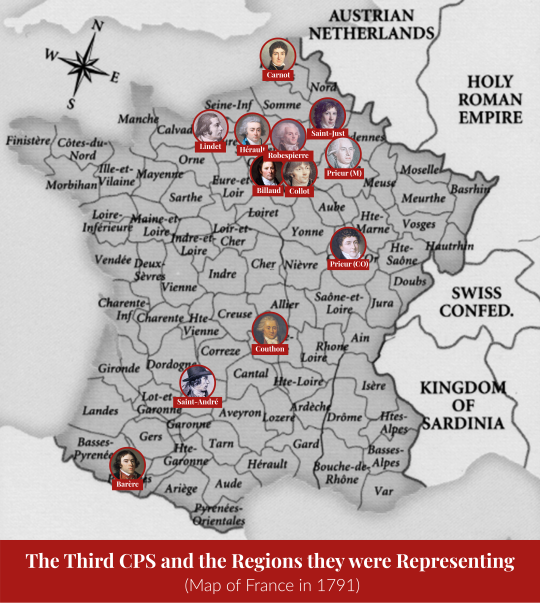
I am geographically challenged, and I really, really wanted a way to visualise what constituencies the members of the Third Committee of Public Safety ( July 1793 – July 1794) represented. So, this map was born.
Bertrand Barère: Hautes-Pyrénées
Jacques Billaud-Varenne: Paris
Lazare Carnot: Pas-de-Calais
Jean-Marie Collot: Paris
Georges Couthon: Puy-de-Dôme
Marie-Jean Hérault de Séchelles: Seine-et-Oise
Robert Lindet: Eure
Pierre-Louis Prieur de la Marne: Marne (hence the name…)
Claude-Antoine Prieur: Côte-d'Or (ditto)
Maximilien Robespierre: Paris
André Jeanbon Saint-André: Lot
Louis Antoine de Saint-Just: Aisne
PS: It’s fascinating and telling how many of them represented provinces in the north of France.
#frev#robespierre#french revolution#couthon#barere#collot#billaud varenne#herault#lazare carnot#saint just#saint-andre#Committee of Public Safety#priuer
96 notes
·
View notes
Text
Rare footage of what happened after spending a late afternoon at the Rosati with the Trio™ (c. 1788):
Left guy with the cap holding a beer can, who then drunkenly faints: Robespierre
Center redhead with a pizza cutter: Fouché
Right brunet who holds a Bourbon drink and drops it after the first guy falls: Carnot
#idk if anyone has thought abt posting this lmao#frev#french revolution#frev memes#maximilien robespierre#robespierre#joseph fouché#fouché#lazare carnot#carnot
73 notes
·
View notes
Text
The different revolutionary musicians and their way of practicing music:
Sophie Carnot, an accomplished pianist, is the perfect example of a musician with multiple talents. She didn't just play the piano; she also wrote melodies to accompany the poems of her husband, Lazare Carnot, one of the prominent figures of the Revolution.
Lucile Desmoulins, on the other hand, excelled at the piano, but her playing was sometimes tested by the turmoil of the times. When things became too difficult, it seems that music was no longer enough to soothe her soul.
Prieur de la Côte d'Or an important figure of the French Revolution , for his part, was a cellist and guitarist, but also a composer. He wrote music, notably to accompany the poems of his friend Lazare Carnot.
And then there's Louis Delgrès, who played the violin not to soothe the soul, but to taunt the troops of Richepance from the ramparts, according to Lacour Auguste. While the others were composing harmonies for reflection and resistance, Delgrès seemed to think that the best way to play his violin was with a bit more "fanfare"—as if his violin had a mission to make as much noise as possible rather than create delicate melodies! Talk about turning music into a battle cry!

(The face that Delgrès must have made in front of Richepance's troops who came to reestablish slavery when he played the violin)
#frev#french revolution#not a serious post#lazare carnot#claude antoine prieur#lucile desmoulins#sophie carnot#louis delgrès
38 notes
·
View notes
Text

Merry Christmas Frevblr!
I simply draw Carnot and Prieur sleeping. These two nerds need to have a rest.
#lazare carnot#prieur de la côté d’or#claude antoine prieur#french revolution#frev art#my awful art#the csp#frev
24 notes
·
View notes
Text
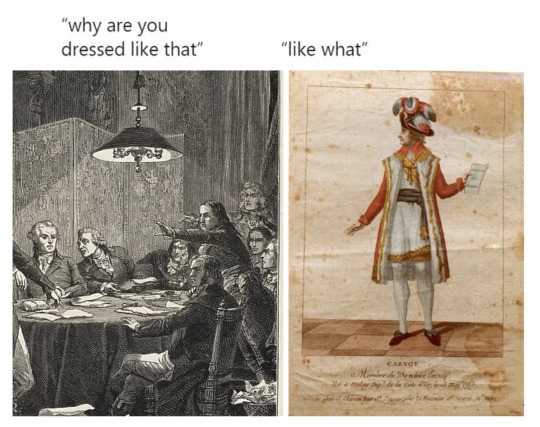
the cps wish they could have outfits as cool as the directors
190 notes
·
View notes
Text
“Go and succeed!” Lazare Carnot, an ideal manager (a story by René Levasseur)
Levasseur arriving to the Army of the North is one of my favorite anecdotes from French revolution, but the way he was sent to it is also iconic.
Carnot became a member of Committee of Public Safety on 14th august 1793. One of the problems he needed to solve first was the Army of the North being near revolt wanting their arrested general Custine back.
Carnot decided that the best decision would be to send Levasseur to the Army. That is how Levasseur describes their conversation in his memoirs (t. 2 p. 23-24):
I met only Carnot, because he was the one responsible for the administration of the armies. <…>
“Army of the North – he [Carnot] said – is in a state of an open revolt. We need a firm hand to suppress it. And we chose yours.”
“That’s an honor to me, Carnot, but the task requires a military talent and a relevant experience. And I possess none.”
“We know you and we appreciate you. A view of such an esteemed man, a friend of liberty and his county will be enough to bring all the lost souls back to the path of duty.”
“But, let me be honest with you, Carnot, my physique is not appropriate either. Look at my small body and tell me how someone with such an appearance could inspire respect in your grenadiers?”
“Alexander magnus corpore parvus erat.” [Alexander was short] Carnot replied.
“Yes, but Alexander spent his entire youth in camps, could use arms and knew how to encourage the troops.”
“My friend! Circumstances are what make people who they are. The firmness of your character and your devotion to the republic are everything.”
“Well then, I agree. With no military knowledge, I promise you to show all zeal and courage. When should I leave?”
“Tomorrow.”
“I’ll be ready.”
“You will receive a decree, a weapon and a uniform tomorrow.”
“And my instructions?”
“They are already in your heart and your head. You’ll follow them when circumstances force you. Your power is unlimited. Go and succeed.”
And Levasseur succeeded.


23 notes
·
View notes
Text
frev doodles 🫡



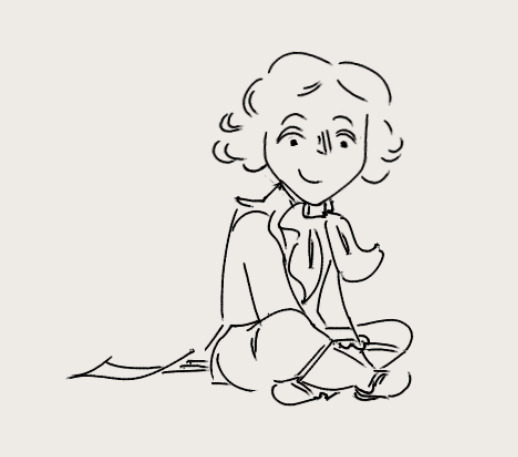
hope you like it :]
#french revolution#frev#collot d'herbois#billaud varenne#louis antoine saint just#maximilien robespierre#lazare carnot#bertrand barère#my art
110 notes
·
View notes
Text
It's not a work by Federico Zardi if there's not at least one scene in which Fouché and Carnot go around arm in arm like school best friends:


from I Giacobini and I Grandi Camaleonti.
42 notes
·
View notes
Text



forgot to post this monster girl design for Carnot and Robi here
I was actually planning to make a darkest dungeon mod with this Vampire Robi but I suck at rigging (in Dragonbone) but I wanna pick it up again (I think I just have to separate the legs so they‘d move properly)
Aaaand I haven’t come up with the abilities yet, just a rough idea that he should be somewhere like the Jester, buffs other character and occasionally attacks with bleeding/self-healing.
#Robespierre#maximilien robespierre#lazare carnot#carnot#darkest dungeon#character design#art#my art#I suck at animation but it’s been like a year now#And still have to draw the little thing for each ability#Frev
128 notes
·
View notes